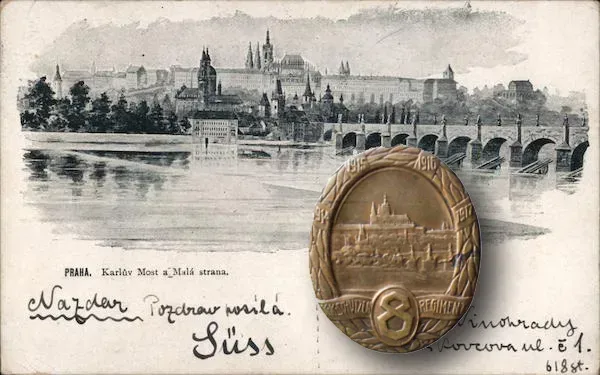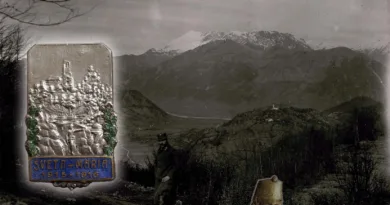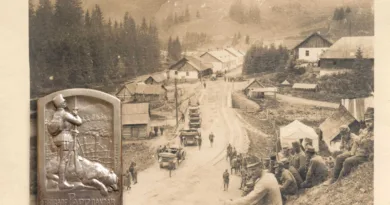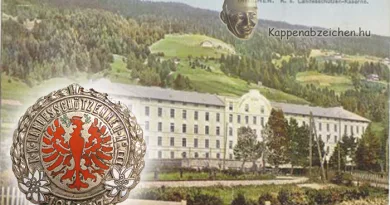Prague/Praha
The Czech capital city does not require a lengthy description. It has been a popular destination today and a long time ago. Lots of foreigners made pilgrimages to see the city’s mysterious medieval monuments. Perhaps it is less well known that the Habsburg reigns also treated the city as a favored residence at one time. Among others, II. Habsburg Rudolph the emperor of the Holy Roman Empire who compulsively believed in alchemy and supported the “goldmakers” in Prague. Maybe that’s where the city’s known name comes from, “golden Prague.”

The badge, postcard and contemporary photo show one of the city’s best-known panoramas. We stand on the edge of the Old Town on the coast of Vltava. To the right, the ancient Charles Bridge leads to the riverside part on the other side, known as the “Mala Strana”. Above that, on the hilltop stands the royal castle. The castle district is mostly built with Renaissance palaces, and there is the Gothic St. Vitus Cathedral and the Royal Palace. The Kappenabzeichen is dominated by the cathedral on the high ground. The windows of stained glass are decorated with the coats of arms of the countries under the Habsburg dynasty. As a youngster I visited twice this place to see the ancient coat of arms of the Hungarian Kingdom. It was not seen in so brilliant layout anywhere in Hungary.
The other emphatic structure is the Charles Bridge. It is one of the oldest bridges in Europe. The early wooden bridge built on the Vltava’s wader was destroyed by a flood in 1342. The bridge, which can still be seen today, was built in its place in the late 1300s. Charles IV, the Emperor of the Holy Roman Empire personally placed his foundation stone. The advice of then fashionable occultism was used to determine the best time to start construction. This was 9th July, 1357 at exactly 5:31 a.m. Despite careful preparation, the construction of the bridge was slow and was not completed until 1402. The contemporary name given to the honor of its builder was not given until 1870. Until then, it was simply called the Stone Bridge. The construction is 516 meters long and 10 meters wide. There are 30 Baroque statues on the terraces above its pillars.

Prague was an important administrative and military center not only in the Middle Ages, but also during the Monarchy. Corps command was based here and several units of various military branches were stationed in the city. The city’s home regiment was the 28th infantry regiment. In 1915, emigrant politicians (e.g. Tomas Masaryk) who worked on the secession of Czechs called on Czech citizens not to fight alongside the Monarchy in a manifesto. As a result of the call, most troops of Czech or Moravian crews, were working on the front lines without enthusiasm. The 28th Infantry Regiment excelled with its complete desertion in 1915. The regiment was then terminated because of the betrayal, removed from the records. The Prague 8th Landwehr (Schützen) Regiment was of better use. The Regiment was part of the 21st Infantry Division. They were deployed mainly on the Russian front. This unit’s badge was decorated with the Prague panorama.




